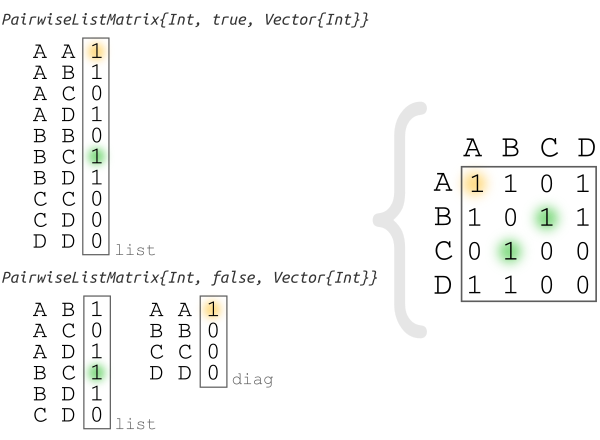This package allows you to use a pairwise list as a matrix:
mutable struct PairwiseListMatrix{T,diagonal,VT} <: AbstractArray{T, 2}
list::VT
diag::VT
nelements::Int
...
endPairwiseListMatrix{T, diagonal, VT} is a (squared) symmetric matrix that stores a list
of type VT with values of type T for the pairwise comparison/evaluation of nelements.
If diagonal is true the first element of the list is 1, 1 otherwise is 1, 2.
If diagonal is false the diagonal values are stored in a vector on the diag field.
In pairwise calculations like cor() if results are saved as PairwiseListMatrix the
space is N(N+1)/2 instead of N*N. This is useful to compare a large number of elements,
because you are saving ~ 50% of the memory.
PairwiseListMatrix is faster than a full matrix to make operatation like sum and
mean in the whole matrix, since it is cache efficient. However it is slower than a full
matrix for reducing along dimensions.
julia> # Pkg.add("PairwiseListMatrices")
julia> using PairwiseListMatrices
julia> plm = PairwiseListMatrix([1,2,3], false)
3×3 PairwiseListMatrices.PairwiseListMatrix{Int64,false,Array{Int64,1}}:
0 1 2
1 0 3
2 3 0
julia> nplm = setlabels(plm, ["a","b","c"])
3×3 Named PairwiseListMatrices.PairwiseListMatrix{Int64,false,Array{Int64,1}}
A ╲ B │ a b c
──────┼────────
a │ 0 1 2
b │ 1 0 3
c │ 2 3 0
julia> table = to_table(nplm)
6×3 Matrix{Any}:
"a" "a" 0
"a" "b" 1
"a" "c" 2
"b" "b" 0
"b" "c" 3
"c" "c" 0
julia> from_table(table, true)
3×3 Named PairwiseListMatrix{Any, true, Vector{Any}}
A ╲ B │ a b c
──────┼────────
a │ 0 1 2
b │ 1 0 3
c │ 2 3 0


